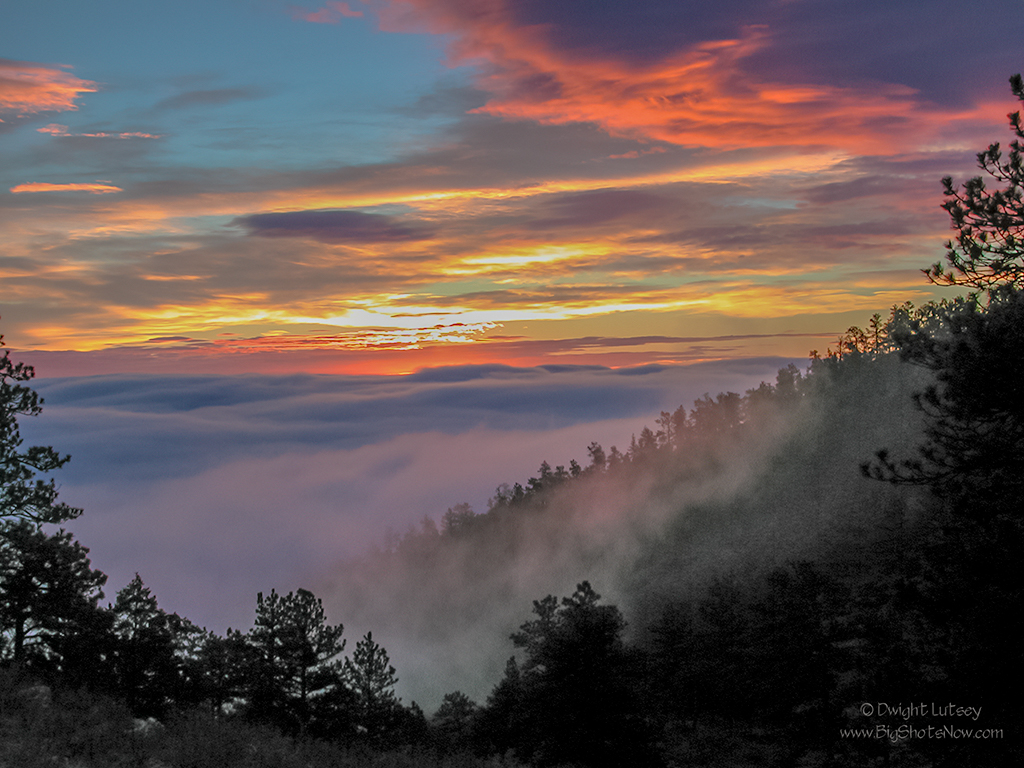For those of you new to the blog you may not know that The Institute, the source of the many excellent but interesting posts you receive daily, sits high in the Rocky Mountains in Northern Colorado. Not Andes high or Himalayan high, but moderately high at just under 6500′.
So what, you might ask, if you were the rude type. Well, it means that at this altitude, 6500′, we get a lot more weather than folks living lower than us. What might be a rain cloud high in the sky to them may be a raging hail storm at this elevation. They’re looking at the bottom of a cloud and don’t see what’s going on inside it. Or a brisk wind down on the flats might be 70 mph up here and that will scatter your lawn chairs all over hell and back.
Lately we’ve been getting a lot of “fronts” moving in which brings clouds over and around us and often below us, usually all at the same time. I say fronts because we rarely get “backs” unless the clouds move backwards for some reason, which it does sometimes for reasons known only to itself. So I guess that could be considered a “back”.
The Institute buildings sit prominently on a point just below the summit of a world-famous mountain, it, the mountain not the Institute, being featured on many maps and even Google Earth, jutting out into space and consequently into the weather whenever it occurs. Visualize all the many imposing Schloss’s or castles you have seen in magazines, movies, and your imagination along with craggy rustic buildings set in high lonely places and mix them together and you have an idea of what The Institute aspires to look like and fails dismally at, and you have an idea of what we look like.
But getting back to the fronts we spoke of earlier. When they bring the clouds in to envelope us in misty darkness, they are loaded to the very gills with water in the form of suspended droplets completely filling the inside of that cloud. There is simply no room left for anything else. Not even lightning. It is packed tight. When the cloud moves back and forth due to some climatic reason it bangs into whatever happens to be there, like say, The Institute, and as it collides with our buildings the water inside the cloud just adheres to them. Sticks to the sides, saturating everything with impunity, and creates problems that are different than one gets in a rainstorm. The water doesn’t just fall downward and run down the sides like rain, it instantly saturates everything, walls, roof, under the eaves, into every single nook and cranny, sort of like running your house through a car wash. Think grabbing your house by its roof and plunging it into a vat of water until bubbles come out of its little chimney and you have some idea of what it’s like to live in a cloud.
Now before you think that that is a totally bad thing, it’s not. In fact it’s kind of cool. If you’ve done all your proper caulking and waterproofing that is. You can stay inside and light a fire in the fireplace without fear of accidentally burning down the forest from errant embers. You can read, pull your chair right up to the window and watch the cloud move back and forth. Drink hot tea. Think about stuff you don’t normally take time out to think about. Ponder, some. Call your neighbors and say “Hey, you got cloud?” They almost always do if you do. It’s a time to relax and say “Well I don’t have to mow the lawn today.” and just enjoy the weather.
There are other good parts too, like when the clouds move in and when they move out. If the movement happens at either end of the day, like sunrise in the shot above, you get a bonus of seeing morning in a different way. That alone makes up for some of the crap side of living in a cloud. Shortly after that image was taken the cloud moved backwards up the hill and we got wet. But for a brief moment you got to see paradise. Living in a cloud isn’t always a bad thing.


You must be logged in to post a comment.